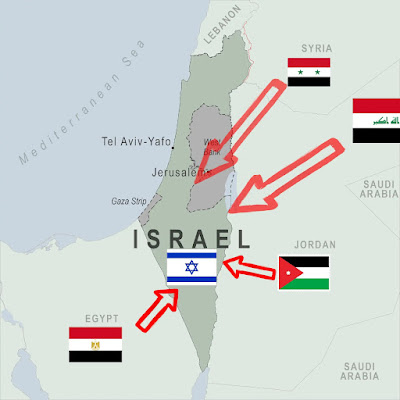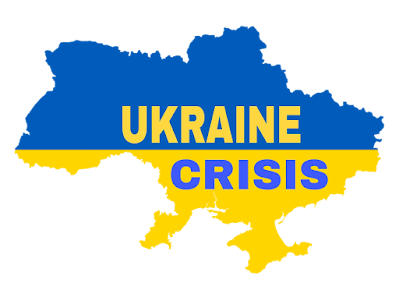The Muslim nations in the Middle East would not accept Israel's existence since its founding in 1948.
They began amassing huge amounts of sophisticated weaponry and lobbying for the implementation of boycotts, divestment, and sanctions against the Jewish State.
Six Day War Causes
On the 15th of May 1967, on Israel's Independence Day, a 3-week period began which was one of the tensest and fearful periods in Israel's history. In direct contravention of international agreements, Egyptian leader Gamal Abdel Nasser removed the UN peacekeeping forces and began moving tens of thousands of soldiers and hundreds of tanks into what was the demilitarized Sinai Peninsula towards Israel's southern border.
Egypt also blockaded the Straits of Tiran, an open international waterway, which was essentially a declaration of war. Israel turned to the nations of the world, primarily to the United States, for assistance against Egyptian aggression but somehow all Western countries decided to remain neutral. Very quickly, it became apparent that the promises were all but forgotten.
Egypt, Syria, Jordan, Iraq, and Lebanon Vs Israel
Israel, with 2.5 million Jews, was left alone to face the might of the Arab nations. Egypt, Syria, Jordan, Iraq, and Lebanon formed a military alliance and began moving forces into Jordan towards Israel's borders. When the Arab countries realized that the world had abandoned Israel, many other Muslim countries were openly calling for the destruction of Israel.
The will and means to murder millions of Jews were evident. Top IDF commanders expressed their concerns that the high price Israel was liable to pay in a war with the Arab world. Some military experts projected a toll between twenty and a hundred thousand lives. Israel prepared cemeteries all over the country ready to accommodate many expected victims. Massive parks were prepared in Jerusalem, Tel Aviv, and other cities, in case the cemeteries would have no more space.
World governments, instead of defending Israel's right to exist, warned Israel continuously not to attack. However, the people of Israel had no choice but to go to war, to defend their country and their very existence.
At 7:15 am on June 5th, 1967, the IDF launched operation "Moked"- Focus. Almost the entire Israeli Air Force was dispatched in a daring mission. Only 12 planes stayed behind. The risk of this operation was extraordinary as the fighter pilots flew at an unprecedented low altitude of fewer than 20 meters above the ground. Egypt had the most advanced ground-air missile defense systems in the Middle East.
Most of the Israeli jets were old and outdated French planes. If the Israeli jets would've been detected, many would have fallen, and Israel would've been left with practically no air force. And then a miracle occurred: The most advanced Russian MiG jets that patrolled the airspace along the borders between Egypt and Israel were, for that one critical hour, grounded. Incredibly, at that very same time, the top commanders of Egypt, Jordan, and Iraq flew together to observe the Egyptian forces invading Sinai. The Egyptian officers had ordered all anti-aircraft units not to fire unless given a direct order as long as they were in flight.
This created total confusion on the Egyptian ground as Israel struck exactly in that window of time. By 7:45 a.m. the High Hand of Providence resulted in the Israeli air force reaching all the Egyptian airfields without even one plane being detected. More than 200 Egyptian planes – almost half of Egypt’s fleet – were almost instantaneously destroyed, also bombing the runways and making impotent the mightiest air force in the Middle East. General Moti Hod, Commander of the Air Force said, The second wave of Israeli jets were directed to Cairo to confront the remains of the Egyptian Air Force. And here another miracle occurred, no less miraculous than the first. Even though Israel had lost the element of surprise, and the anti-aircraft systems were operating with full capacity, Egypt was only able to hit one Israeli plane.
The Israeli Air Force went on to destroy a total of more than 300 Egyptian planes, and every airfield in Egypt was neutralized. It was nothing less than a military miracle... Seemingly impossible... And then another miracle occurred. It was as if God hardened the heart of Egyptian president Nasser who continuously gloated about his glorious military victory over Israel.
In the Arab media, President Nasser spoke of the end of Israel's airforce and of the Egyptian tanks on their way to Jerusalem. Jordan, Syria, and Iraq believed these bombastic statements and wanted to join in the "great victory against the Jews". All the Arab airpower struck simultaneously on multiple fronts. In almost any other scenario, Israel would not have been able to respond as quickly as it did.
The timing was seemingly orchestrated to position Israeli jets exactly where they should be. Not in six days, but in six hours the war was won. And then, perhaps, the greatest miracle of all... A miracle Israel never expected – Jerusalem. Again, it seemed as though it was a Divine appointment in time. Jerusalem was to be restored to the Jewish People, after 2,000 years. The enemies of Israel had twice as many soldiers as we did, three times as many planes, four times as many tanks. The odds were stacked against us on every military front.
Aftermath of Six-Day War
The love of Israel, self-sacrifice, and courage of the Israeli soldiers combined with Divine guidance and assistance made these miracles possible. Yitzchak Rabin, then Chief of Staff, was given the honor of giving the war its name. He chose the Six-Day War recalling the six days of creation as Israel too was created with the liberation of Jerusalem. As the center of gravity of the Jewish people has now returned to the land of our fathers, the Torah center of the world has once again returned to Jerusalem.
The Chief Rabbinate of the State of Israel has established the 28th of Iyar – a Day of Hallel and Hodaya, praise, and thanks for the salvation of our people and the liberation and return of our capital Jerusalem. Jews in Israel and in every country in which they reside come together in prayer and celebration. Similar to Chanukah and Purim, it sometimes takes many years for the miracles to be fully recognized and celebrated.
The Mizrachi World Movement is involved in massive community-wide celebrations across the globe from London to Los Angeles, from Melbourne to Johannesburg, to Chicago and Toronto. For 2,000 years our hope never died. Our faith as a people never wavered. Wherever Jews were, whenever they prayed, they prayed to face Jerusalem. Whatever happened the night before, whether it was the Crusades, the Inquisition, Muslim oppression, or Nazis in Germany, the next morning, a Jew would wake up, dust himself off, put on his tallit, face Jerusalem and pray to come home, knowing somehow, someway, God would bring us back.
This is our greatest celebration. To be alive in this generation, where the prayers of our fathers and mothers have finally been answered, to be alive and to take part in Jewish destiny. To experience miracles of Divine Providence, Bayamim Hahem Bazman Haze, like in those days but in our time.


















